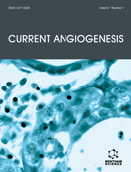Abstract
In the last four decades the recognition of a tumor’s fundamental need of an expanding blood vessel network for successful development and growth has led to the identification of novel cancer therapeutic targets. As a consequence anti-angiogenic therapy has now become a common therapeutic modality in cancer treatment. However, patients often do not respond to the currently available anti-angiogenic agents or become resistant to them upon prolonged exposure. Thus, the full potential of anti-angiogenic therapy is yet to be realized and alternate modes of angiogenesis inhibition are needed. Recently a new target in the angiogenic process was identified. The angiopoietin/Tie axis is important in vascular development and plays a role in the maintenance or destabilization of blood vessels. Angiopoietin-1 (Ang-1) is secreted by peri-endothelial cells (e.g. smooth muscle cells and pericytes) and interacts with Tie2 receptor in a paracrine manner, promoting a quiescent vascular phenotype. Angiopoietin-2 (Ang-2) is secreted by endothelial cells during angiogenic stimulus and interacts with Tie2 in an autocrine manner, disrupting endothelial and peri-endothelial cell interactions of normal vessels. Ang-2 is commonly upregulated in tumors and in some cancer settings correlates with advanced disease and poor prognosis. As a result Ang-2 has become a desirable therapeutic target and several Ang-2 inhibiting agents are currently in preclinical or clinical development. This reviews focuses on the current status of these agents and discusses future considerations for Ang-2 targeting in cancer therapy.
Keywords: Angiopoietin-2, anti-angiogenic agent, cancer therapy, Tie2, tumor vasculature, vascular targeted therapy.
 22
22

